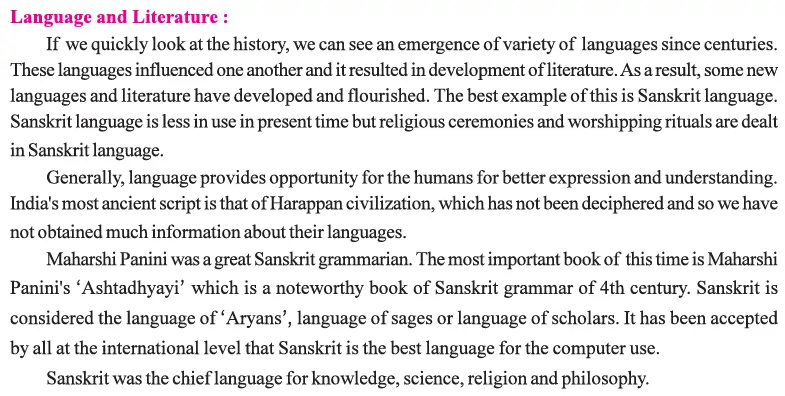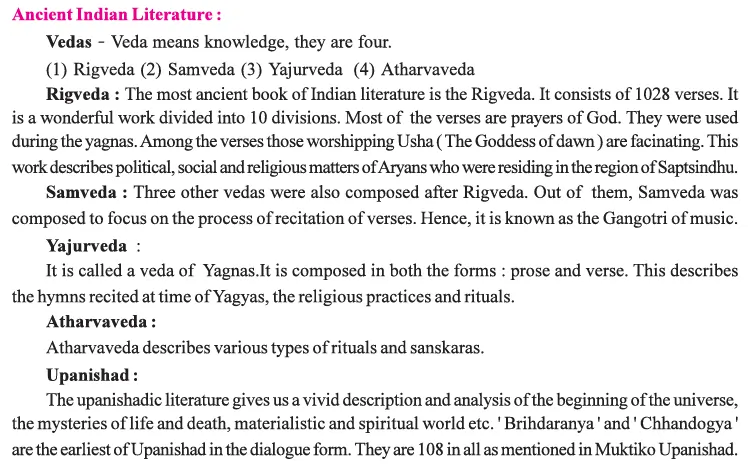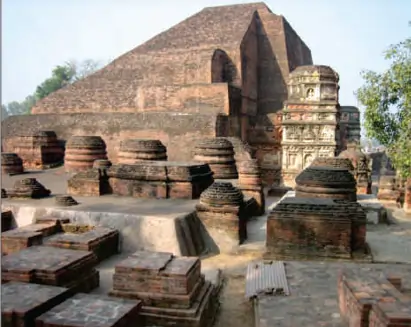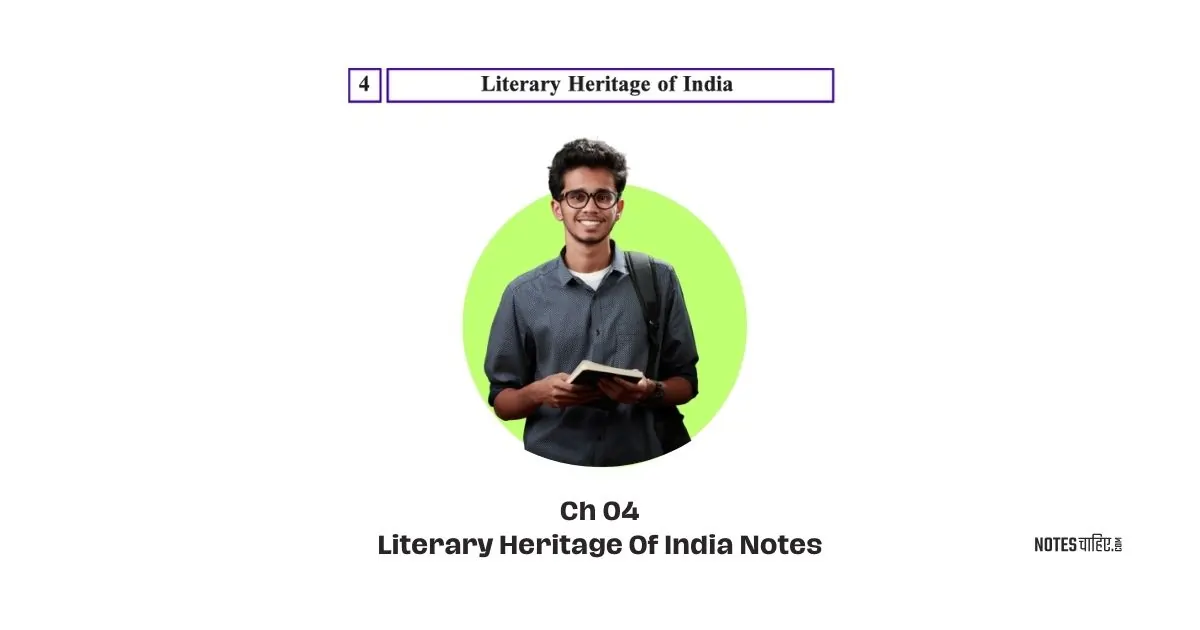GSEB Class 10 Social Science Chapter 04 Literary Heritage Of India Notes to learn fast and easy to remember is here on NotesChahiye.
We have created the complete book notes topic wise. The note is in points and tabular format so that you can retain them easily and you can save your time.
Humans, seeking to convey thoughts and emotions, initially employed expressions, symbols, and sounds, leading to the creation of dialects and scripts as effective communication tools.
Language, evolving from these mediums, became a powerful means of expressing ideas, eventually giving rise to literature.
In the context of Indian literature, renowned for its diversity, ancient works were classified into Vedic and classical forms, alongside the popularity of folk literature.
This rich literary heritage showcases humanity’s innate desire to communicate, share experiences, and preserve cultural narratives.
Language and Literature Notes

History of Languages:
- Languages developed over centuries, like Sanskrit, which played a vital role in ancient times.
- Sanskrit is still important for religious ceremonies.
Why We Use Language:
- Languages help us express ourselves and understand each other.
- The Harappan script shows India’s diverse languages, even though it’s not fully understood.
Maharshi Panini and Sanskrit Grammar:
- Maharshi Panini, a Sanskrit grammar expert, made a big impact around the 4th century.
- His book ‘Ashtadhyayi’ is a key work in Sanskrit grammar.
Sanskrit as Aryan Language:
- Sanskrit was the language of Aryans, sages, and scholars in ancient times.
- Internationally, Sanskrit is considered ideal for computers.
Sanskrit’s Many Uses:
- Sanskrit was used for knowledge, science, religion, and philosophy.
- Its influence in various areas shows how versatile and important it is.
Ancient Indian Literature Notes

Vedas:
- Veda means knowledge; there are four Vedas.
- (1) Rigveda
- (2) Samveda
- (3) Yajurveda
- (4) Atharvaveda
Rigveda:
- Oldest Indian literature with 1028 verses.
- Divided into 10 sections, mostly containing prayers used in yagnas.
- Describes political, social, and religious aspects of Aryans in Saptsindhu.
Samveda:
- Composed for recitation of verses.
- Known as the Gangotri of music.
Yajurveda:
- Veda of Yagnas, composed in both prose and verse.
- Describes hymns, religious practices, and rituals during Yagyas.
Atharvaveda:
- Describes various rituals and sanskaras.
Upanishad:
- Offers insights into the universe, life, death, and spirituality.
- ‘Brihdaranya’ and ‘Chhandogya’ are early dialogic Upanishads.
Brahmanical Literature:
- Epics composed to understand Vedic literature.
- Explains Vedic literature and principles of behavior.
Aranyakas:
- Philosophical literature composed during the last phase of life in forests.
Vedangas:
- Deals with religious practices, rituals, grammar, astrology, and astronomy.

Epics – Ramayana and Mahabharata:
- ‘Ramayana’: Story of Ramchandra, King of Ayodhya, smaller in size.
- ‘Mahabharata’: World’s largest epic, one lakh verses, narrates the war between Kauravas and Pandavas.
- ‘Bhagwad Gita’: Part of Mahabharata, explains deep philosophical principles for ‘Moksha.’
Sanskrit Literature:
- Combined religious and worldly aspects during this period.
- Puranas played a key role in explaining early Vedic religion.
Buddhist Literature:
- Initially written in Pali, known as ‘Tripitika’ with three sections.
- Gupta period was a golden period for Sanskrit poems and dramas.
Gupta Period Writers:
- Kalidas, Bhavbhuti, Bharvi, Banabhatt, Mangha.
- Kalidas’ works renowned globally for poetic and dramatic style.
Works of the Period:
- Bana’s ‘Kadambari’ and ‘Harsha Charit,’ Bhavbhuti’s ‘Uttar Ramcharit,’ Bharavi’s ‘Kiratarjuniyam,’ Vishakhadatta’s ‘Mudra Raksha,’ Shudrak’s ‘Mrichchhkatikam,’ Dandi’s ‘Dashkumarcharita.’
- Themes included political events, romance, allegories, comedies, and philosophy.
Early Gujarati Literature:
- Verses in early Gujarati language.
- Narsinh Mehta, Mirabai, Dayaram, Akho, Premchand, Pritam enriched the heritage.
Later Gujarati Scholars:
- Narmad, Navalram, Kishorlal Mashruwala, Pannalal Patel, Umashankar Joshi, Mahipatram Ruparam Nilkanth, Goverdhanram Tripathi contributed to Gujarati literature.
Dravidian Languages and Literature:
Tamil:
- Oldest Dravidian Language.
- Belongs to early centuries of the Christian era.
- Developed its own script and literature.
Literary Gatherings and Sangams:
- Three sangams held, featuring sages and poets reciting compositions.
- Themes included politics, war, and love.
Key Works:
- “Ethutokoi” – Composition of 8 poems.
- “Tolkappiyam” – Grammar.
- “Patthuppattu” – The 10 songs.
Thiruvalluvar’s Contribution:
- Thiruvalluvar wrote ‘Kurai,’ a verse dealing with various aspects of life and religion.
Famous Epics:
- “Shilppadikaram” and “Manimekhalai” are renowned works in early Tamil literature.
Medieval Literature Notes

Early Medieval Sanskrit Works:
- North Indian literature in Medieval times centered on Sanskrit.
- Notable works: ‘Kathasaritsagar’ by Somdeva, ‘Rajtarangini’ by Kalhana.
Sanskrit Poetry:
- ‘Geetgovind’ by Jaydeva stands out.
- Apabhramsa languages evolved into modern Indian languages.
Emergence of Hindi Literature:
- ‘Prithviraj Raso’ by Chandbardai marks Hindi’s early development.
- Southern poets like Pampa, Ponna, and Ranna contribute to early Kannada literature.
Delhi Sultanate Influence:
- Promotion of Khadi Boli and Brij Bhasha.
- Popular Rajasthani heroic poems: ‘Alha’ and ‘Udal.’
Persian Influence and Historiography:
- Persian becomes Delhi Sultanate’s court language.
- Historians like Ziauddin Barani contribute to Persian literature.
Amir Khusro – Literary Icon:
- Amir Khusro excels in poetry, history, mysticism, and music.
- Advocates synthesis of Hinduism and Islam.
Regional Language Flourish:
- Regional kings support languages like Awadhi, Bhojpuri, and Bengali.
- Tulsidas’s ‘Ramcharit Manas’ in Awadhi gains prominence.
Bhakti Movement Influence:
- Bhakti saints like Kabir contribute devotional poetry.
- Chaitanya initiates devotional songs, shaping regional literature.
Kashmir and Vijaynagar Contributions:
- Zainulabidin translates Sanskrit to Persian in Kashmir.
- Telugu literature thrives under King Krishnadevarai in Vijaynagar.
- Mughal Period Literary Development:
- ‘Tuzuk-e-Babar’ and ‘Humayun-nama’ significant autobiographical works.
- Akbar’s reign sees Hindi literature flourish with Tulsidas, Surdas, and Keshavdas.
- Abul Fazl and Persian Translations:
- Abdul Fazl’s ‘Ain-e-Akbari’ offers insights into Indian life.
- Akbar supports Sanskrit to Persian translations, fostering cultural exchange.
- Birth of Urdu Language:
- Medieval period witnesses Urdu’s birth.
- Poets like Wali, Mir Dard, and Ghalib shape Urdu literature.
- Early 18th century witnesses the rise of Urdu prose.
- Historical works translated from Sanskrit into Urdu gain prominence.
- Simultaneously, original prose works in Urdu start to appear.
- ‘Darbar-e-Akbari’ by Muhammad Hussain Azad stands out.
- Offers valuable insights into the court of Akbar.
In summary, Medieval India’s literary diversity reflects a rich cultural and linguistic tapestry, with contributions in various languages.
The Ancient Universities of India Notes

Nalanda:
- Located in Badgaon village, Patna district, Bihar.
- Famous from 5th to 11th centuries; pinnacle of Indian education.
- Kumar Gupta built monastery; home to priceless manuscripts.
- Attracted global students, including Huen Tsang.
- Dharmgunj library; ideal Indian student from Nalanda.
Takshashila:
- In Rawalpindi, Pakistan; capital of ancient Gandhar.
- 64 subjects; students practiced with gurus.
- Renowned in 7th century; Chanakya, Prasenjit studied.
- Visited by Fa-Hien in 5th century.
Varanasi (Kashi):
- Pilgrimage site; education hub in 7th century.
- King Ajatshatru supported education.
- Maharshi Vedvyas’ ashram; Lord Buddha propagated teachings.
- Adishankaracharya adopted Vedanta principles.
Vallabhi:
- In Gujarat; 7th-century education center.
- Vansh Dynasty; Hinayana Buddhism led by Sthirmati & Gunmati.
- Competed with Nalanda’s fame; supported by Maitrak Dynasty.
- Inscribed scholars’ names; erudition earned higher rights.
- International university under kings and landlords.
Ancient universities shaped India’s rich education and culture.


Leave a Reply